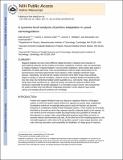A systems-level analysis of perfect adaptation in yeast osmoregulation
Author(s)
Muzzey, Dale; Gomez-Uribe, Carlos A.; Mettetal, Jerome T.; van Oudenaarden, Alexander
DownloadVan oudenaarden_A systems-level.pdf (2.049Mb)
OPEN_ACCESS_POLICY
Open Access Policy
Creative Commons Attribution-Noncommercial-Share Alike
Terms of use
Metadata
Show full item recordAbstract
Negative feedback can serve many different cellular functions, including noise reduction in transcriptional networks and the creation of circadian oscillations. However, only one special type of negative feedback (“integral feedback”) ensures perfect adaptation, where steady-state output is independent of steady-state input. Here we quantitatively measure single-cell dynamics in the Saccharomyces cerevisiae hyperosmotic shock network, which regulates membrane turgor pressure. Importantly, we find that the nuclear enrichment of the MAP kinase Hog1 perfectly adapts to changes in external osmolarity, a feature robust to signaling fidelity and operating with very low noise. By monitoring multiple system quantities (e.g., cell volume, Hog1, glycerol) and using varied input waveforms (e.g., steps and ramps), we assess in a minimally invasive manner the network location of the mechanism responsible for perfect adaptation. We conclude that the system contains only one effective integrating mechanism, which requires Hog1 kinase activity and regulates glycerol synthesis but not leakage.
Description
available in PMC 2011 June 7.
Date issued
2009-07Department
Harvard University--MIT Division of Health Sciences and Technology; Massachusetts Institute of Technology. Department of Biology; Massachusetts Institute of Technology. Department of PhysicsJournal
Cell
Publisher
Elsevier B.V.
Citation
Muzzey, Dale et al. “A Systems-Level Analysis of Perfect Adaptation in Yeast Osmoregulation.” Cell 138.1 (2009): 160–171. Web.
Version: Author's final manuscript
ISSN
0092-8674
1097-4172